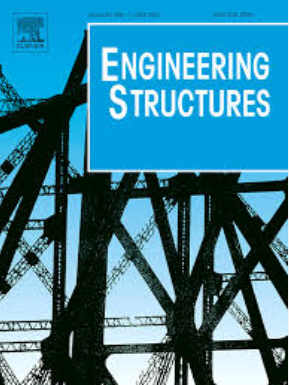Seismic vibration control of monopile supported offshore wind turbines by tuned mass dampers considering seabed liquefaction
IF 5.6
1区 工程技术
Q1 ENGINEERING, CIVIL
引用次数: 0
Abstract
Seismic vibrations and site liquefaction are of great concern in offshore wind engineering, as many offshore wind turbines (OWTs) have been constructed in seismically active areas with sandy seabed. Previous studies have reported that tuned mass dampers (TMDs) with precise tuning are an effective means of controlling seismic excessive vibrations of OWTs. However, liquefaction can change the natural frequencies of OWTs, and the potential failure of tuning-sensitive TMDs is not fully appreciated. The aim of this study is to investigate the vibration control of OWTs by single/dual TMDs under the co-actions of earthquakes and seabed liquefaction. Firstly, a nonlinear model is established to simulate the seismic response of a monopile supported 5 MW OWT in sandy sites, and the effect of liquefaction on the soil-structure interaction (SSI) is considered. In addition to the observed significant threat of strong earthquakes to the safety service, liquefaction can result in a notable reduction in the first two natural frequencies of the OWT. TMDs are believed to mitigate the negative impacts of potential liquefaction. Secondly, a linear elastic two-degrees-of-freedom (2DOFs) analytical model of OWT-TMD is presented to optimize the TMDs, and the effect of liquefaction on the OWT is simplified as frequency drops of the first two eigenfrequencies. The 2DOFs linear theory is chosen due to its high efficiency and wide applicability. Finally, the feasibility of the proposed method is validated, and it is found that the dual TMDs optimized based on the proposed linear theory are effective and robust for OWT’s nonlinear seismic vibration with possible soil liquefaction.
求助全文
约1分钟内获得全文
求助全文
来源期刊

Engineering Structures
工程技术-工程:土木
CiteScore
10.20
自引率
14.50%
发文量
1385
审稿时长
67 days
期刊介绍:
Engineering Structures provides a forum for a broad blend of scientific and technical papers to reflect the evolving needs of the structural engineering and structural mechanics communities. Particularly welcome are contributions dealing with applications of structural engineering and mechanics principles in all areas of technology. The journal aspires to a broad and integrated coverage of the effects of dynamic loadings and of the modelling techniques whereby the structural response to these loadings may be computed.
The scope of Engineering Structures encompasses, but is not restricted to, the following areas: infrastructure engineering; earthquake engineering; structure-fluid-soil interaction; wind engineering; fire engineering; blast engineering; structural reliability/stability; life assessment/integrity; structural health monitoring; multi-hazard engineering; structural dynamics; optimization; expert systems; experimental modelling; performance-based design; multiscale analysis; value engineering.
Topics of interest include: tall buildings; innovative structures; environmentally responsive structures; bridges; stadiums; commercial and public buildings; transmission towers; television and telecommunication masts; foldable structures; cooling towers; plates and shells; suspension structures; protective structures; smart structures; nuclear reactors; dams; pressure vessels; pipelines; tunnels.
Engineering Structures also publishes review articles, short communications and discussions, book reviews, and a diary on international events related to any aspect of structural engineering.
 求助内容:
求助内容: 应助结果提醒方式:
应助结果提醒方式:


